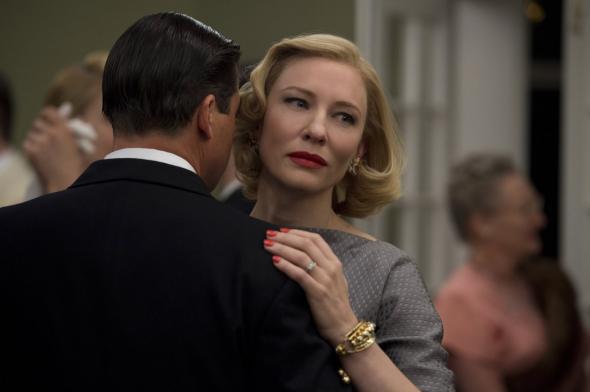The glance of recognition. The glare of suspicion. If one wanted to reduce the queer experience to its most basic and universal components, the profound necessity of looking—for each other in a sea of straightness and for signs of hostility in that same mass—would have to be high on the list. Queer people are forced to become experts at looking in order to locate opportunities for romantic or communal connections (our identities are not necessarily visible), as well as to ensure our own safety (because sometimes they are). We are always scanning our surroundings, always taking stock of the scene, always aware of ourselves in relation to others—whether we’d like to be or not.
When I say that Carol, the rapturous new Todd Haynes period piece based on Patricia Highsmith’s novel The Price of Salt, is the best queer film I have seen this year (and perhaps in many years), it is largely due to how incredibly well Haynes and his actors weave looking into their work. Haynes bookends the story—which follows an electric, if circumstantially difficult, romance between middle-aged socialite and mother Carol (played with almost unbearable smolder by Cate Blanchett) and ingénue shop girl/aspiring photographer Therese (Rooney Mara) in early 1950s New York—with two of the most thrilling looks of queer desire I have ever encountered.
Early in the movie, there’s Carol, absent-mindedly perusing Christmas presents in a midtown department store, when she happens to glance across the sales floor and notice Therese looking all cutely tomboyish behind the doll counter, an intriguing mixture of boredom and distraction coloring her soft features. Carol senses that the shop girl shares her disinterest in the hetero-family consumer circus annoyingly humming between them. Her gaze and quiet smile to the alluring stranger communicate this and something more: I know you. And much later, after Therese and Carol have truly gotten to know one another—along with the difficulties of being in a lesbian relationship decades before Stonewall—they share another glance across a room full of straight obstacles. This time it’s a well-heeled dinner club, and their look is freighted with the weight of a tumultuous history—but the recognition, both a shiver and a relief, is the same. I know you.
This careful rendering of the miracle of queer connection is a large part of what gives Carol its sensuous power. It’s a miracle that Therese strives to capture in her hungry photographs and that Carol herself conveys in a mantra she repeats while marveling at Therese: “Flung out of space.” Straight people have the luxury of moving through the world with the basic assumption that most everyone they meet experiences sexual attraction and gender expression as they do. Meanwhile, queer people are mulling about in their midst, carefully looking for others like ourselves. This was especially true in the pre-liberation past in which Carol takes place and is still largely true today in much of the world beyond queer-tolerant cities. When you finally encounter another like you—and particularly when romantic chemistry is involved—it can indeed feel like a gift from the universe, a blessing flung out of space.
But Carol understands the other side of the queer need to look as well, the side that’s concerned with self-preservation in the face of heterosexist surveillance. This film is infused with moments when Carol, Therese, and Carol’s ex-now-friend, Abby (Sarah Paulson), find themselves under the suspicious gaze of straight people. There are the everyday instances, such as Carol’s maid eyeing her employer’s female visitor from the kitchen, Carol’s estranged husband glowering at Therese, or the curious glances that various hotel employees offer Carol and Therese during a road trip through the Midwest. Then there’s the uniquely queer experience of being worried about straight people noticing your own moment of queer connection, such as when Therese nervously notices a lesbian couple noticing her in front of the straight male proprietor of a record store. And finally, at the climax of the film, there’s a moment in which straight surveillance becomes so literal that it’s difficult to watch.
If it’s Carol and Therese’s looking at each other that gives Carol its simmer, it is the constant straight surveillance of them that gives the film its suspense. The exhilaration you feel at the end of Carol comes directly from the interplay between these two elements—these women cannot help but lock eyes, even when doing so means they risk catching fire under the hot glare of everyone around them.
Toward the end of the movie, Carol defends a hard choice with regard to her daughter with a moving testament to living honestly: “What use am I to anyone, to her, if I’m living against my grain?” Powerful words, and yet, for queer people, living with our grain necessarily forces us against the grain of straight society. That friction can be thrilling, like when you surreptitiously identify the other gay guy at a straight party and make yourself known with little more than a tilt of the head. Or it can be harrowing, as when even walking too close to your partner draws whispers and stares in certain parts of town. But both are a fundamental part of what it means to be other. That Carol understands this truth and reflects it back in such a gorgeous and compelling way is more than enough reason to give it a look.
